

While competitors chase the latest AI tools, successful companies focus on proven frameworks that transform AI potential into measurable business performance. The difference is strategic thinking over technology obsession. Our AI Implementation Framework shows you how to build these Agentic systems that deliver measurable results. The six-phase methodology has guided dozens of organizations from AI experimentation to AI-driven growth.
Traditional automation follows simple rules. You program it, and it executes. But AI agents operate in a completely different paradigm; they perceive context, reason through complexity, and adapt based on outcomes.
Think of the difference between a calculator and a financial analyst. Both process numbers, but only one understands what those numbers mean for your business. Multi-agent systems amplify this advantage. When AI agents collaborate, they create capabilities that transcend individual limitations:
Here's what makes collaborative AI different: distributed intelligence across specialized functions.
One agent recognizes customer intent while another optimizes recommendations based on that understanding. Together, they solve problems neither could handle alone. It's like building an expert team instead of hiring a generalist.
Organizations implementing multi-agent frameworks consistently report:
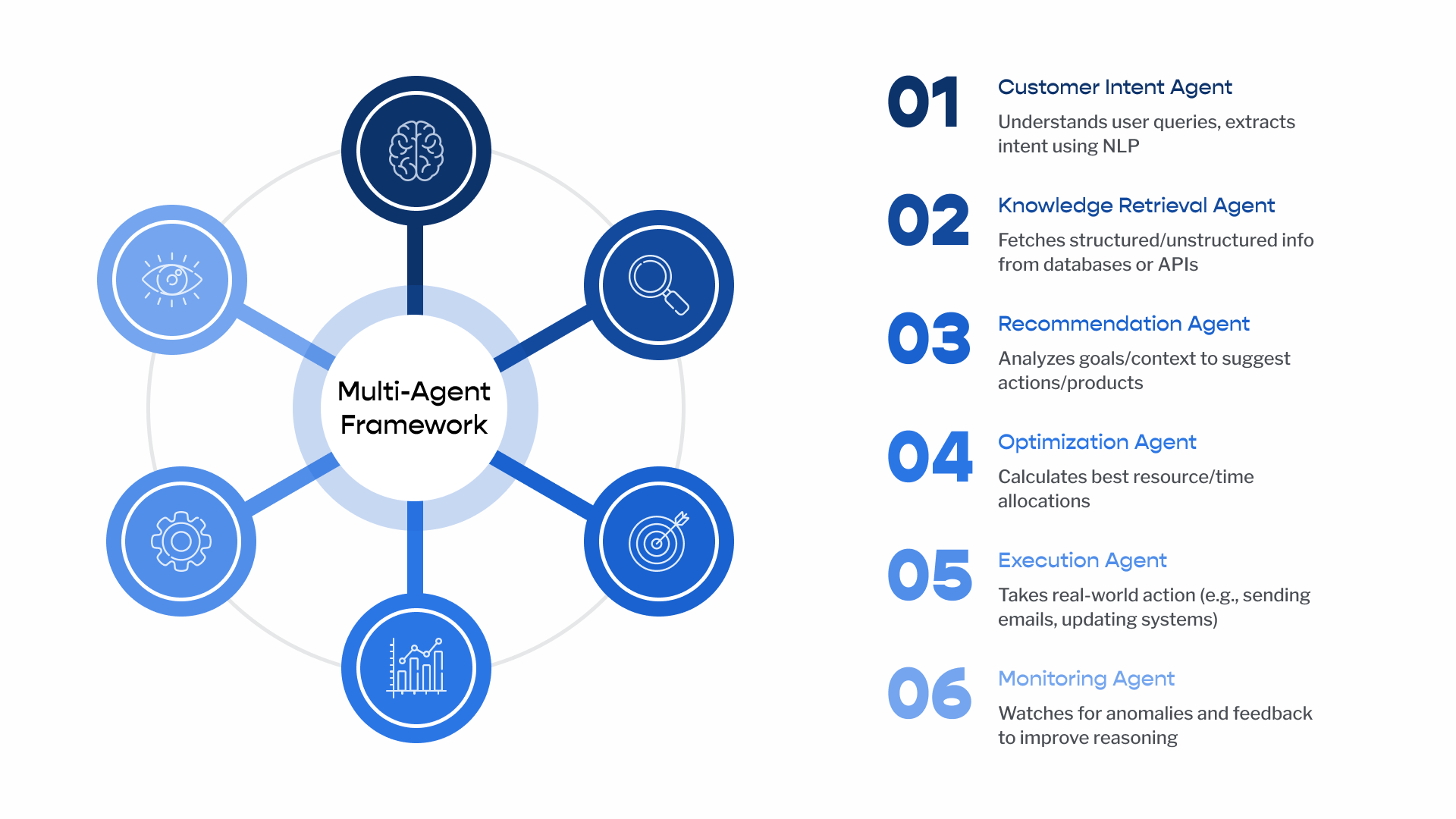
Most AI transformations fail because organizations skip the strategic groundwork. You need a proven framework that strikes a balance between ambition and pragmatic execution. Successful AI implementation fundamentally changes how work gets done across your organization. The journey from concept to enterprise transformation requires balancing ambition with pragmatism, innovation with stability.
Our six-phase framework provides proven methodologies that minimize risk while maximizing value. Each phase builds on the previous one, creating momentum that transforms early wins into sustained advantage.
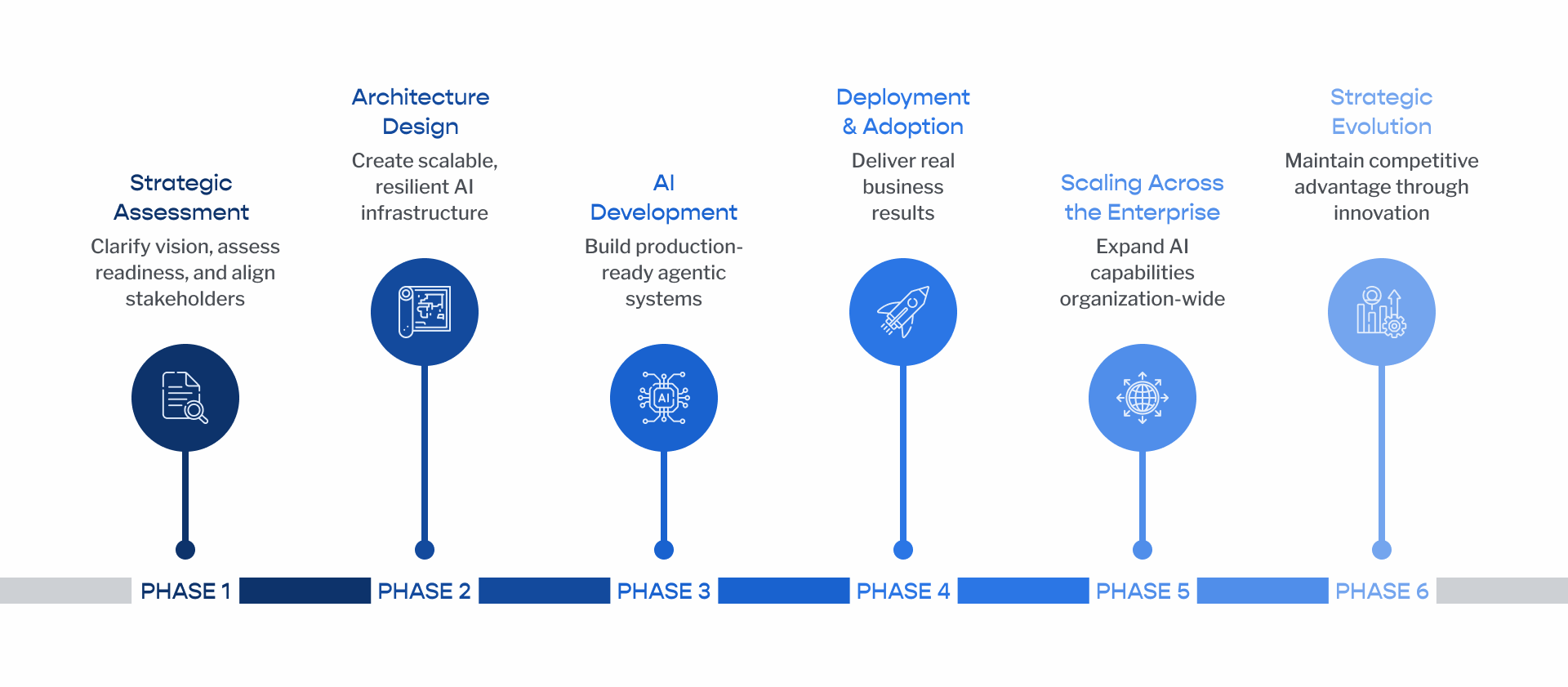
Every AI transformation begins with honest assessment. Where are you today? Where do you need to be? What stands between your current state and future vision?
Strategic assessment separates successful artificial intelligence adoption from expensive failures. We're talking about critical thinking, not paper exercises delegated to consultants.
Document your technology ecosystem. Map every automation tool, manual process, and system integration. Can your ERP communicate with your CRM in real-time? Do your APIs handle the data volumes AI agents generate? These technical realities define what's possible.
Capture performance baselines across three dimensions:
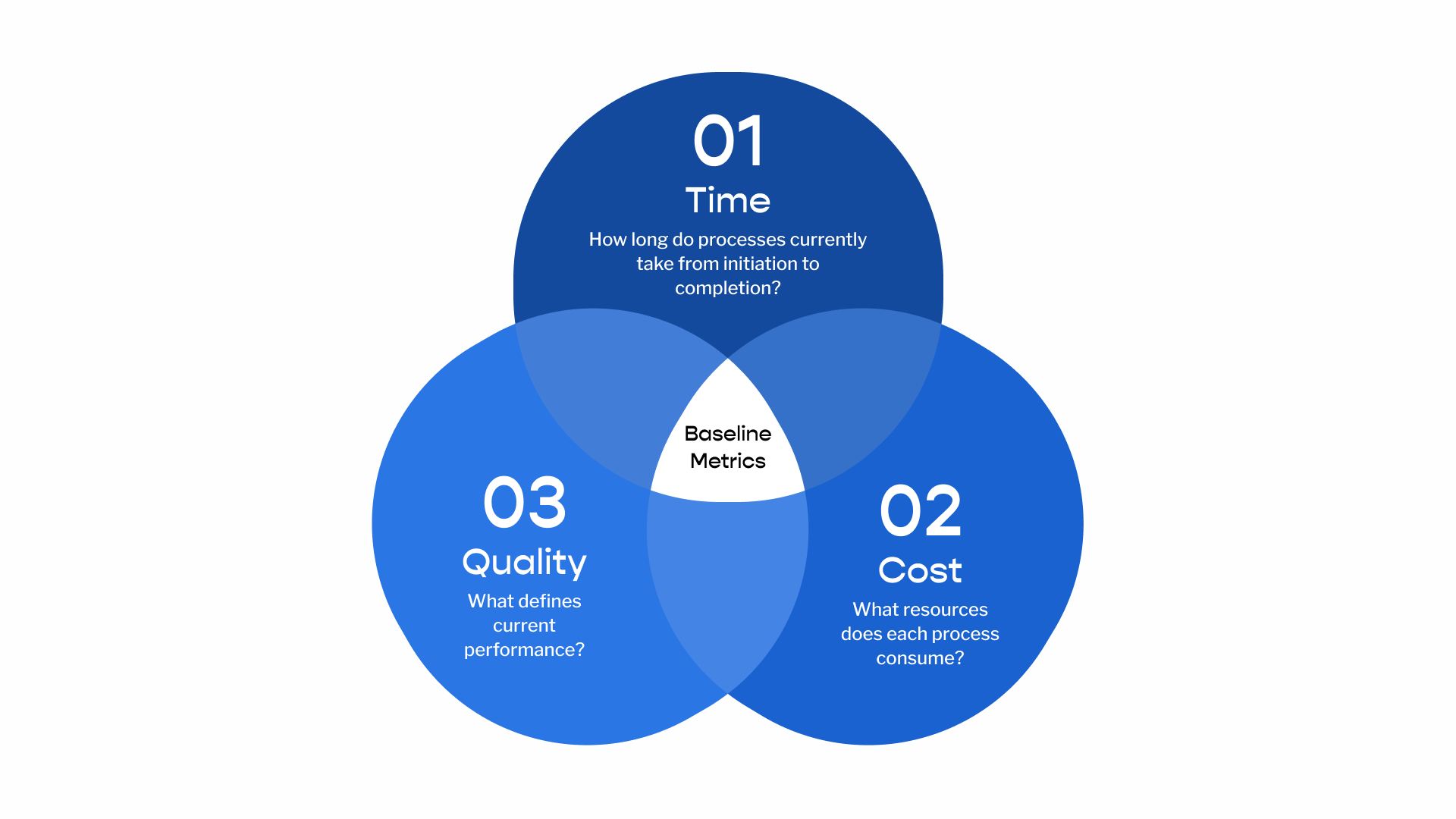
Skills assessment often reveals surprising gaps. You might have strong technical teams but lack AI expertise. Or possess AI knowledge but have limited change management capability.
Where should you start your AI transformation? Target processes combining high business impact with moderate technical complexity. High impact builds organizational support through visible value. Moderate complexity ensures achievable wins.
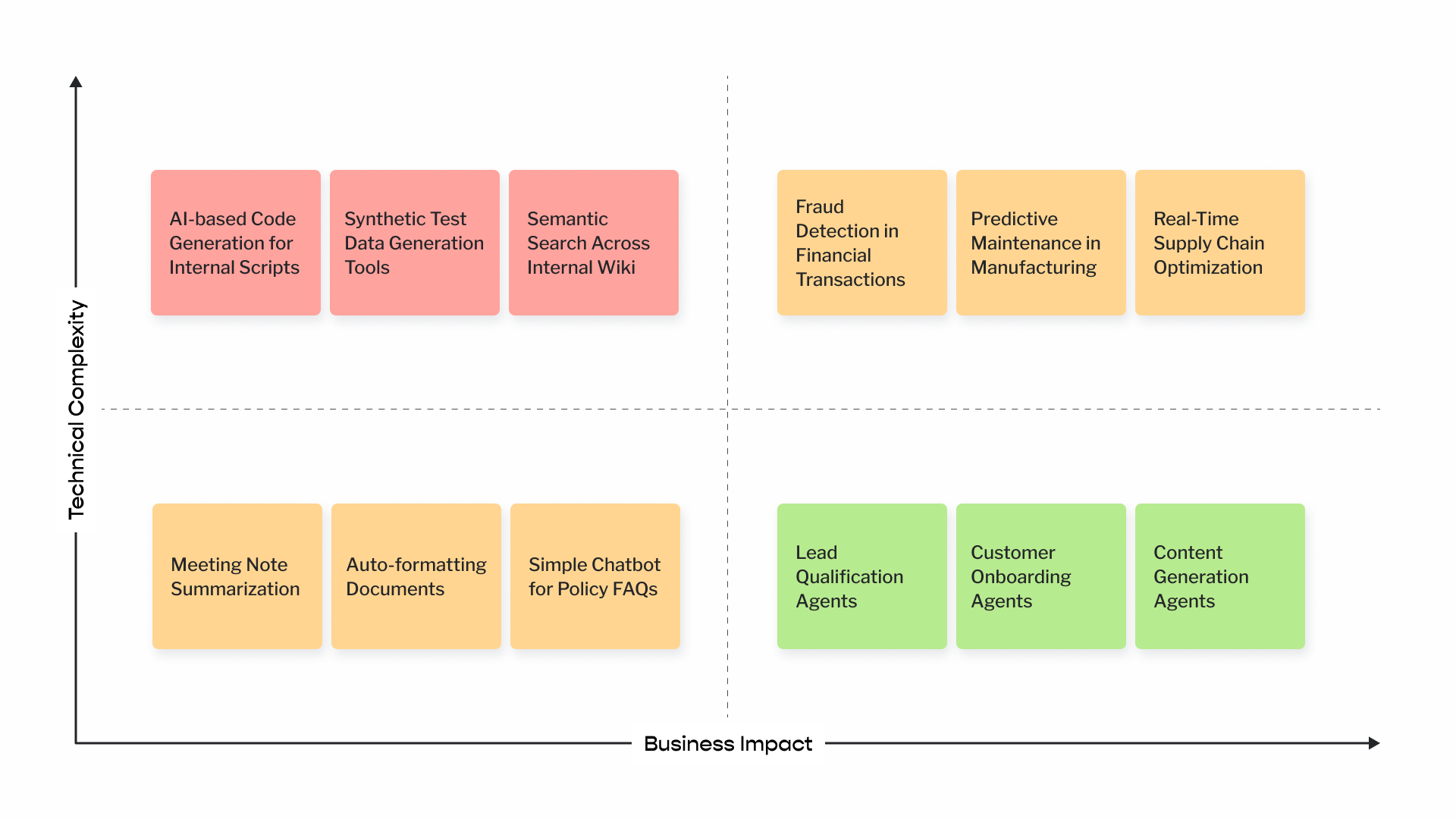
Top-performing AI implementation starting points:
Your business case needs concrete financial impact. Define specific outcomes: AI agents reducing processing time by 60% to save $400K monthly, or improving satisfaction scores by 15 points to cut $2M in annual churn.
Stakeholder alignment starts during assessment, not deployment. Build your coalition with:
Managing AI Implementation Risks
Risk assessment brings healthy paranoia to planning. You'll face predictable challenges, including data quality issues, complications with legacy systems, employee resistance, regulatory constraints, and infrastructure strain. For each risk, develop specific mitigation strategies tailored to address it. If data quality concerns you, build cleansing processes into Phase 2. If you anticipate change resistance, design pilot programs that prove value before broader rollout.
The decisions you make during architecture design will echo throughout your entire AI transformation. Choose poorly, and you'll fight technical constraints forever. Design thoughtfully, and your system evolves gracefully with growing demands.
Strategic assessment reveals what you need to build. Architecture design determines how to build it. This phase transforms business requirements into technical blueprints that guide your AI implementation.
Most organizations underestimate the impact of architecture on their artificial intelligence strategy. The framework you choose, the integration patterns you design, and the security models you implement shape everything that follows.
Multi-agent systems require different architectures for different business needs. Your choice depends on how your teams actually work and collaborate.
Three primary architecture patterns:
Your framework choice shapes your entire AI transformation:
Enterprise IT is messy. Your AI agents must navigate legacy systems without APIs, cloud services with different authentication methods, and on-premise databases with strict access controls.
Design for bi-directional data flow from day one. Ensure robust error handling for when systems inevitably fail. Your AI implementation success depends on handling these technical realities, not ignoring them.
Critical integration requirements:
Technical architecture provides the foundation, but process design defines whether your AI agents create real business impact.
Map every step, decision, and handoff in your target processes. But here's the key insight: don't simply digitize what exists today. AI capabilities open new possibilities.
Which steps become unnecessary when agents handle data gathering automatically? Where do human touchpoints add genuine value versus perpetuating outdated procedures? Challenge every assumption about how work must flow.
When multiple agents work together, their coordination patterns shape overall effectiveness. Choose patterns that match your business rhythm and complexity.
Four orchestration approaches:
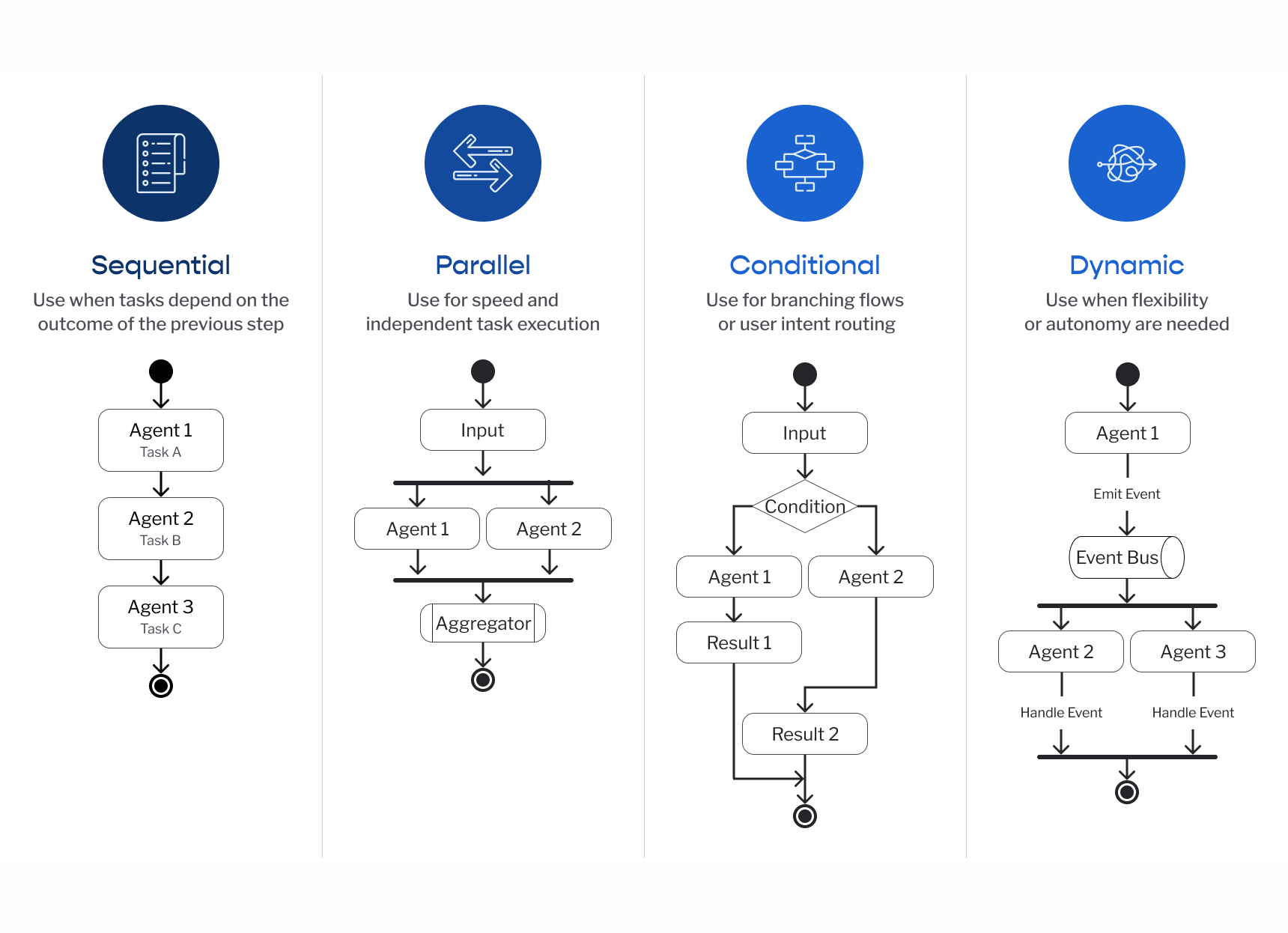
The relationship between human judgment and AI automation evolves over time. Start with conservative boundaries that build organizational confidence:
Agents recommend actions while humans retain approval authority. Routine cases flow to agents while exceptions escalate to specialists. Each human decision teaches agents, gradually expanding their autonomy.
Months of planning now transform into working systems. This phase reveals which organizations can execute their AI strategy and which remain stuck in endless planning sessions.
Modern AI implementation requires specialized infrastructure beyond traditional software tools. Your development stack needs MLOps platforms for experiment tracking, vector databases for semantic search, and orchestration frameworks for agent interactions.
Whether you choose cloud platforms like AWS SageMaker or build with open-source tools, ensure your environment supports rapid iteration and seamless deployment.
User experience design begins before development starts. Validate workflows through prototypes and mockups—discovering users hate your interaction model after building it wastes months of effort.
Test early concepts with real users. How will they know when an agent is processing? What visual cues indicate confidence levels? When do they need to override decisions?
Essential UX design elements:
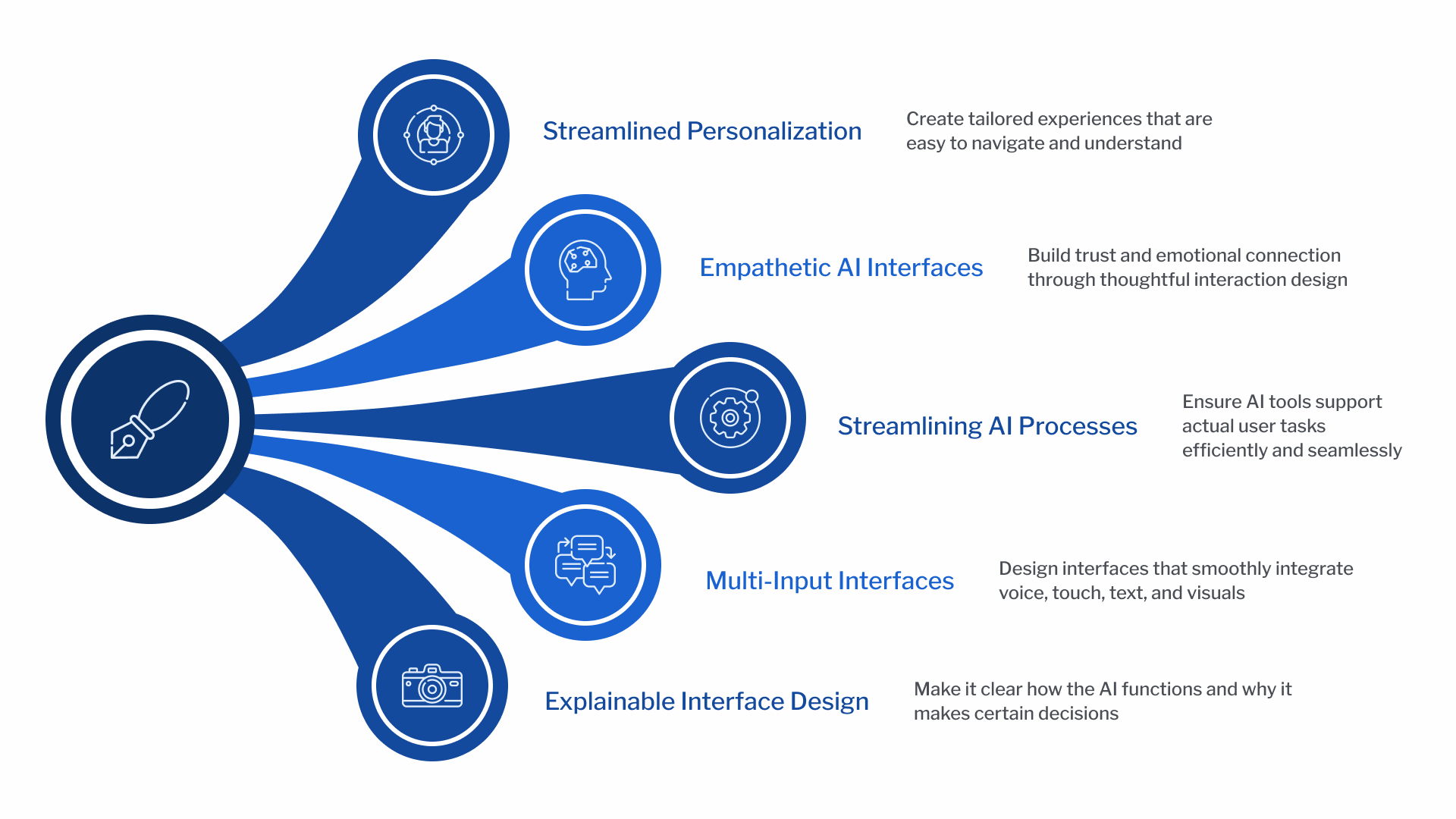
Generic AI models need transformation into domain experts who understand your specific business reality. Feed them historical data, but curate carefully—your past decisions often include outdated policies or biases you want to eliminate.
Build comprehensive test suites that catch performance issues before production. Can agents accurately classify thousands of customer inquiries? Do they extract correct data from your messiest documents?
Integration development creates connections between agents and enterprise systems. This unglamorous work determines whether agents operate on real-time data or outdated approximations.
Focus on resilience from day one:
Test integrations under realistic conditions: simulate peak loads, network failures, and malformed data. What seems solid in development often crumbles when facing production chaos.
Maintain focus on business outcomes during artificial intelligence development. User acceptance testing confirms that agents solve real problems in ways that feel natural to users.
Their feedback reveals assumptions that made sense to developers but break down in practice. Document operational procedures, troubleshooting guides, and integration specifications as you build.
Phase 3 transforms your AI strategy into working systems that users trust and operators can maintain, setting the foundation for the scaling phases in our comprehensive framework.
The journey from successful testing to production value is where many AI implementations stumble. Deployment demands careful orchestration, while optimization transforms early wins into lasting competitive advantage.
Your pilot launch sets the tone for enterprise-wide artificial intelligence adoption. Choose participants who represent target users but bring forward-thinking mindsets. You need people who communicate clearly about what works and what doesn't.
During the pilot phase, measurement becomes critical. Track every agent decision, response times, error patterns, and resource usage. Most importantly, watch how users actually interact with agents versus your expectations.
Essential pilot feedback collection:
Different users require different support approaches. Power users seek deep configuration knowledge, while daily users need streamlined workflows. Managers focus on interpreting analytics, and executives evaluate strategic impact.
Effective AI training blends hands-on workshops, video tutorials, reference guides, and peer mentoring. This variety ensures every user finds their preferred learning path.
Track metrics across both technical and business dimensions. System health indicators like uptime and response times ensure reliable operations. Business metrics like cost savings, revenue growth, and user satisfaction demonstrate tangible value.
Leading indicators help you spot emerging trends early, while lagging indicators validate long-term AI transformation impact.
Build support that grows with your deployment. Tier 1 resolves routine questions, Tier 2 handles technical complexities, and Tier 3 tackles architectural challenges.
User communities naturally share best practices while feedback loops ensure support evolves alongside user needs.
Your initial AI wins created momentum. Now stakeholders across the organization want their agent-powered transformations. Phase 5 channels that enthusiasm into sustainable, enterprise-wide AI capability.
Each department demands unique AI solutions. Customer service prioritizes satisfaction and resolution speed. Finance requires unwavering accuracy with complete audit trails. Sales teams need agents that enhance conversion while building relationships.
The key to successful AI transformation lies in maintaining core architecture while allowing functional flexibility. Keep authentication, monitoring, and security standards consistent across deployments. But let agent logic adapt to each department's specific workflows and success metrics.
This approach prevents the chaos of isolated AI implementations while ensuring each team gets solutions that actually work for their reality.
Scaling artificial intelligence successfully means embedding continuous improvement into your organization's DNA. Create rhythms that drive evolution:
Without these learning systems, your AI implementation stagnates while competitors advance.
Expanding AI adoption requires governance frameworks that provide visibility and control without creating bureaucracy that kills innovation.
Track deployments through centralized registries. Establish performance benchmarks ensuring quality while allowing experimentation. Implement security standards protecting data without blocking progress.
Focus on enablement over restriction: Your governance should make AI implementation easier for departments, not harder.
Mature AI implementations adopt a hub-and-spoke structure. A central team maintains platforms and standards while distributed teams build department-specific solutions.
This model eliminates redundant development, creates infrastructure economies of scale, and ensures tailored AI solutions without sacrificing agility. Shared knowledge repositories capture lessons learned while innovation labs explore emerging capabilities.
This phase transforms isolated AI successes into organization-wide intelligence that compounds in value—preparing you for the final optimization phase in our complete AI implementation framework.
Static AI systems become tomorrow's technical debt. Organizations that evolve continuously compound their artificial intelligence value while competitors struggle to catch up.
New AI capabilities constantly emerge, but not all deserve your attention. Evaluate each through practical business criteria: What specific problem does this solve? How complex is integration? Will users embrace the change?
Consider technologies enhancing existing agents—newer language models for better accuracy, computer vision for document processing, voice interfaces for natural interactions, or predictive analytics that anticipate rather than react.
Balance innovation enthusiasm with operational stability. Your AI transformation requires steady progress, not constant disruption.
Early AI adopters watch fast followers close gaps using better tools and learned lessons. Organizations still hesitating face mounting pressure as artificial intelligence shifts from advantage to necessity.
Stay ahead by:
Your competitive position depends on continuous advancement, not one-time implementation success.
The real AI implementation prize extends beyond efficiency gains. Artificial intelligence enables new business models—services impossible with human labor become profitable at scale. Previously unserved markets become accessible.
Ask transformational questions:
Your competitive advantage widens through reimagining possibilities when intelligent agents augment human capability at scale.
Phase 6 ensures your artificial intelligence implementation evolves strategically, maintaining competitive advantage through continuous innovation and market adaptation.
Implementing AI agents successfully requires strategic thinking, careful planning, and commitment to change management. Organizations following this structured approach consistently report higher success rates and faster time-to-value.
The strategic question has shifted. How quickly can you transform AI potential into performance? Every day of delay widens the gap between leaders and laggards. Every successful implementation makes the next one easier.
Ready to lead rather than follow? Book a discovery session with our team to explore how AI agents can accelerate your strategic goals.
We’d love to bring your ideas to life.
Tell us what you’re thinking — and we’ll help shape it.

AI automation means using large language models (like GPT-4) to handle repeatable tasks inside your business. We design and build custom agents that can qualify leads, summarize content, route tickets, trigger workflows, or power internal copilots.

Not at all. While we specialize in building intelligent systems, we also offer full-service UX/UI and product design — from discovery to delivery. Many of our clients come to us purely for design support, with or without AI.

We collaborate with startups, scale-ups, and enterprise teams across fintech, SaaS, healthcare, e-commerce, logistics, and more. Whether you’re building your first product or scaling a complex system, we adapt to your stage and stack.

Absolutely. We run UX audits, onboarding redesigns, and complete product design engagements. Whether you're looking to clean up a dashboard, increase activation, or launch a new feature — we’ve got the design depth to support it.

Yes — that’s the core of what we do. We build agents that connect directly to your tools (Slack, Notion, HubSpot, CRMs, internal platforms), automate actions across them, and fit how your team already works. No need to change your stack.

No — we design every system to be maintainable without in-house ML engineers. We handle the technical setup, logic, and integrations, and offer optional support plans to monitor and optimize performance post-launch.

That’s totally fine. You can engage us for standalone UX/UI work, product discovery, or AI automation — or combine them. We’re built to plug into your priorities and scale with your roadmap.